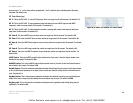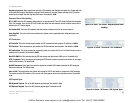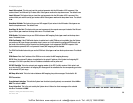
40
Chapter 6: Using the Web-based Utility
The Voice Tab
IP Telephony System
Multicast Address. This is the IP address (and port number) used by the System to send control messages to all
clients at the same time. It must be a multicast address and must contain a port number. The default is
224.168.168.168:6061.
Group Page Address. This is the IP address (and port number) used by the System to tell clients to send and
receive group page RTP packets. It must be a multicast address and must contain a port number. The default is
244.168.168.168:34567.
Max Expires. This sets the maximum allowed Registration Expires value (in seconds) for clients. The default is
3600.
Force Media Proxy. This feature forces external clients to use the System’s media proxy when exchanging RTP
traffic with external peers. Select yes or no from the drop-down menu. The default is no.
Proxy Debug Option. SIP messages are received at or sent from the proxy listen port. This feature controls
which SIP messages to log. Select none for no logging. Select 1-line to log the start-line only for all messages.
Select 1-line excl. OPT to log the start-line only for all messages except OPTIONS requests/responses. Select
1-line excl. NTFY to log the start-line only for all messages except NOTIFY requests/responses. Select 1-line
excl. REG to log the start-line only for all messages except REGISTER requests/responses. Select 1-line excl.
OPT|NTFY|REG to log the start-line only for all messages except OPTIONS, NOTIFY, and REGISTER
requests/responses. Select full to log all SIP messages in full text. Select full excl. OPT to log all SIP messages
in full text except OPTIONS requests/responses. Select full excl. NTFY to log all SIP messages in full text except
NOTIFY requests/responses. Select full excl. REG to log all SIP messages in full text except REGISTER
requests/responses. Select full excl. OPT|NTFY|REG to log all SIP messages in full text except for OPTIONS,
NOTIFY, and REGISTER requests/responses. The default is full.
Call Routing Rule. This is a special dial plan that determines which line can be used for an external, outbound
call request from a phone based solely on the target public number. When you create this rule, follow this format:
(rule|rule|rule|...|rule)
The most specific rules should be placed first.
Each rule should be in this format: <:Lx>pattern
L indicates Line (phone line).
The variable x is 1, 2, 3, or 4 depending on which line you want to specify.
The word pattern indicates any digit pattern (see the Dial Plan setting for more information).
VoIPon Solutions www.voipon.co.uk sales@voipon.co.uk Tel: +44 (0) 1245 600560


















